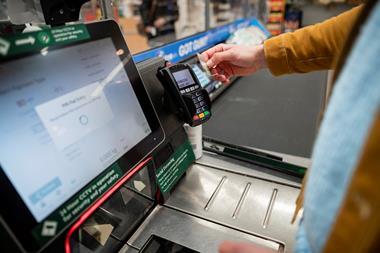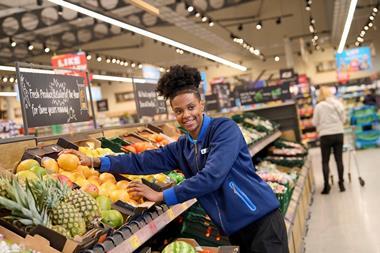>>David Young, head of marketing at Kitchen Range Foods, says retailers could do a lot more with in-store bakery
We all know that branding is a key tool in differentiating and communicating products’ emotional and rational benefits, and it is something which applies to retailers as much as it does to manufacturers.
It has been used to great effect in so many areas of stores and yet in some areas - in-store bakery especially - nearly all products fall under own-label brands.
In-store bakery is a hero category - a vital part of the consumer offer. It is early in the flow of a shop and fresh-looking products and fresh smells help to reinforce the positive images that are set up in the fruit and vegetable aisles.
It has a high level of consumer participation and continues to deliver strong growth: it is second only to fresh produce in driving customer satisfaction.
Consumers like to be able to see a fresh offering, and great quality fresh bread is an essential part of delivering an outstanding and differentiated offer. But while the wicker baskets and theatre of a high-street bakery are delivered in the speciality bread section, cakes and pastries are generally packed in regimented rows of acetate trays, which makes for a potentially colourless display.
Although this acetate packaging is very closely associated by consumers with freshness, it does mean that the fixture lacks a little of the theatre which features in many other parts of the store. There are none of the brand signposts associated with other categories such as the orange of Uncle Ben’s or the red of Kit Kat.
Some good solutions have reached the cheese aisle in recent years. Where often great Cheddars once sat in clear, dowdy packaging looking like commodity offerings, we can now see much more variation in packaging and an increase in more convenient formats.
But most retailers in the UK have thus far struggled to significantly differentiate their cakes and pastries offers to the same degree they have with fresh bread offerings.
Although brands form an important part of a store’s offering, and ‘pillar brands’ such as Sainsbury’s Taste the Difference play an important role, they are not as visible in the in-store bakery section.
Could retailers differentiate their offering more through the use of both their pillar brands and certain snacking and impulse brands? Pillar brands could help to build a
clearly differentiated offer within in-store bakery for their consumers.
Snack and impulse brands could be used to build on the impulsive nature of spend within certain sectors within in-store bakery cakes and pastries. Branding may not be right for all products in in-store bakery but there is massive potential for products with the right brands in the right areas.
Take the example of donuts, which is the largest segment in in-store bakery cakes and pastries. In general, donuts have seen few changes beyond different fillings in the last few years. A lack of good new product development has left donuts failing to meet a growing number of potential eating occasions and so other products have been able to take sales away from the category.
Using our experience of understanding eating occasions in and out of home, Kitchen Range Foods could see that introducing a product that stood out on shelf would have a massive advantage in in-store bakery, and that branding could be an important part of that.
We tied up with Cadbury to bring that brand identity to in-store bakeries. By packing Cadbury’s Mini Dipping Donuts - packs of mini donuts with Cadbury Milk Chocolate dips - in clear packs with brightly coloured sleeves, the consumer can still see the product, helping to reinforce the fresh image despite the fact that they are delivered frozen to stores and placed on to the bakery shelf once defrosted.
Initiatives such as this can bring new life to in-store bakeries by attracting a younger and more affluent audience.
We all know that branding is a key tool in differentiating and communicating products’ emotional and rational benefits, and it is something which applies to retailers as much as it does to manufacturers.
It has been used to great effect in so many areas of stores and yet in some areas - in-store bakery especially - nearly all products fall under own-label brands.
In-store bakery is a hero category - a vital part of the consumer offer. It is early in the flow of a shop and fresh-looking products and fresh smells help to reinforce the positive images that are set up in the fruit and vegetable aisles.
It has a high level of consumer participation and continues to deliver strong growth: it is second only to fresh produce in driving customer satisfaction.
Consumers like to be able to see a fresh offering, and great quality fresh bread is an essential part of delivering an outstanding and differentiated offer. But while the wicker baskets and theatre of a high-street bakery are delivered in the speciality bread section, cakes and pastries are generally packed in regimented rows of acetate trays, which makes for a potentially colourless display.
Although this acetate packaging is very closely associated by consumers with freshness, it does mean that the fixture lacks a little of the theatre which features in many other parts of the store. There are none of the brand signposts associated with other categories such as the orange of Uncle Ben’s or the red of Kit Kat.
Some good solutions have reached the cheese aisle in recent years. Where often great Cheddars once sat in clear, dowdy packaging looking like commodity offerings, we can now see much more variation in packaging and an increase in more convenient formats.
But most retailers in the UK have thus far struggled to significantly differentiate their cakes and pastries offers to the same degree they have with fresh bread offerings.
Although brands form an important part of a store’s offering, and ‘pillar brands’ such as Sainsbury’s Taste the Difference play an important role, they are not as visible in the in-store bakery section.
Could retailers differentiate their offering more through the use of both their pillar brands and certain snacking and impulse brands? Pillar brands could help to build a
clearly differentiated offer within in-store bakery for their consumers.
Snack and impulse brands could be used to build on the impulsive nature of spend within certain sectors within in-store bakery cakes and pastries. Branding may not be right for all products in in-store bakery but there is massive potential for products with the right brands in the right areas.
Take the example of donuts, which is the largest segment in in-store bakery cakes and pastries. In general, donuts have seen few changes beyond different fillings in the last few years. A lack of good new product development has left donuts failing to meet a growing number of potential eating occasions and so other products have been able to take sales away from the category.
Using our experience of understanding eating occasions in and out of home, Kitchen Range Foods could see that introducing a product that stood out on shelf would have a massive advantage in in-store bakery, and that branding could be an important part of that.
We tied up with Cadbury to bring that brand identity to in-store bakeries. By packing Cadbury’s Mini Dipping Donuts - packs of mini donuts with Cadbury Milk Chocolate dips - in clear packs with brightly coloured sleeves, the consumer can still see the product, helping to reinforce the fresh image despite the fact that they are delivered frozen to stores and placed on to the bakery shelf once defrosted.
Initiatives such as this can bring new life to in-store bakeries by attracting a younger and more affluent audience.














No comments yet